
The May apartment building, in the Goose Hollow area of Portland, was consumed in a four-alarm blaze on May 16, 2023.
Kristian Foden-Vencil / OPB
This spring, a four-alarm fire inside downtown Portland’s May Apartments sent smoke billowing across the city and cost more than 100 people their homes.
Rumors about the fire’s cause began before the flames went out. Tavin Davis, 14, stood outside the yellow caution tape watching firefighters work that day and repeated what he’d been told, “I heard some guy got evicted and he set his apartment on fire.”
Inside the tape, fire investigators had already heard the same thing. Lt. Jason Andersen of the Portland Fire Bureau’s arson investigations unit says rumors can be helpful. But they’re the start of an investigation and certainly not the end.
“We knew very quickly that this was going to be a complex investigation,” Andersen said.
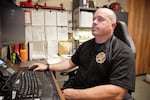
Lt. Jason Andersen of the Portland Fire Bureau’s arson investigations unit. June 21, 2023
Kristian Foden-Vencil / OPB
Andersen’s team set out for the May from their downtown offices before they even got a call to report to the fire scene. They’d heard the radio chatter and knew everyone — a list that in this case included insurance companies, the city and the Oregon Department of Environmental Quality, not to mention residents like Davis — needed to know how the fire started as soon as possible.
Once they arrived, Andersen said, investigators, “threw out the anchor,” meaning they slowed their actions and avoided getting wrapped up in the chaotic scene. That allowed them to calmly set up their equipment and start collecting as much data as possible.
“That consists of interviewing witnesses, examining the scene, documenting the scene, taking photographs, reviewing those photographs, doing research on the property,” Andersen said.
The aim was to establish a baseline. For example, which doors were open, how many hoses were trained on the building, which windows were broken and when — anything that would affect their ability to understand the fire’s spread and eventually find its cause.
They also took pictures, including of the crowd that included Tavin Davis. In Andersen’s experience, most arsonists don’t hang around to watch their crimes play out. Still, investigators never know which details might lead to an ultimate answer.

After the fire at the May Apartments was out, firefighters used a drone to gauge the safety of entering the building to investigate. May 17, 2023
Kristian Foden-Vencil / OPB
Technology has made fighting fires and investigating them easier over the years. The day of the May fire, a group of firefighters happened to be training on drones. They were able to bring the devices to the May and fly them above the building. That helped show crews holes in the roof and therefore the best spots to train hoses.
“This was the first time we’ve actually deployed a UAS (Unmanned Aircraft System) during active fire suppression operations,” Andersen said.
Once the fire was under control, investigators headed inside
“Our biggest physical evidence we have in most cases is walls, ceilings, floors, furniture, all of that tells a story,” Andersen said. “We look for fire effects and fire patterns that help us to determine where that fire started.”
For example, imagine investigators spot a black trail of soot leading from a wall plug might indicate an electrical problem. Portland doesn’t have the money for an electrical engineer, so in a case such as that, they might turn to insurance companies.
“A private fire investigator may go in and may be able to hire an electrical engineer to evaluate that outlet and say, ‘This was not the outlet,’” said Andersen.
Insurance companies did pay to put up security fencing around the May Apartments, and for a structural engineer to gauge whether it was safe to go inside.
Investigators like to get into a building before firefighters tear into walls and crawl spaces to mop up hot spots. That work can destroy evidence.
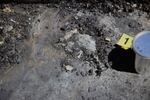
Investigators say lots of evidence is preserved, even in a big fire. This small charred patch is the remains of a gas canister.
Portland Fire Bureau
But even if a fire has completely gutted an area, Andersen said, lots of evidence remains. For proof, he pulls up a picture on his computer. It looks like a small pile of charred trash to the untrained eye. In the next picture, the pile has been turned upside down – revealing the unmistakable bottom of a bright red gas canister.
“Most people think that physical evidence is destroyed. No, it is not destroyed. It is still present,” Andersen said. “It’s up to us to find it.”
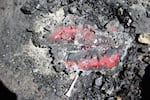
Turn a pile of charred trash over and it can be revealing. This is the remains of a red gas canister.
Portland Fire Bureau
Even liquid gasoline can survive a blaze.
“It can seep underneath the carpet down in the crack of the subfloor underneath the end table leg,” he said.
It’s not the liquid gas that ignites, but rather the vapors because they’re surrounded by oxygen.
From under Andersen’s desk, Kiki the bureau’s ignitable liquids detection dog, groans as if to agree. She can detect 40 different kinds of accelerants and she costs $25,000 to train, courtesy of an insurance company.
She’s needed because electronic detectors have trouble differentiating between accelerants and other burnt smells.
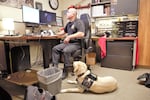
Kiki, a dog who is part of Portland's arson investigations team, can detect 40 different kinds of accelerants and she costs $25,000 to train, courtesy of an insurance company.
Kristian Foden-Vencil / OPB
Andersen says witness interviews are also important in fire investigations. He wants to know what witnesses saw and the location of potential combustibles, like paint cans and cooking oils.
He recently investigated a fire in which it looked like an accelerant had been spread all over a kitchen. But the resident explained that a pan of cooking oil had caught fire. He picked it up to take it outside and accidentally splashed burning oil everywhere.
Andersen says some witness stories, like that one, add up. Others do not.
“I know what a gallon of paint thinner on the floor would look like,” he said. “If there’s a big enough pattern, it’s not a gallon of paint thinner, it’s five gallons of paint thinner.”
Also, people don’t tend to keep paint thinner in a kitchen or a living room.
Over the years, Andersen said investigators have relied less and less on firefighter experience and more on science. For example, old firefighters used to tell new recruits that black soot on a window indicated accelerant. Now they know this can mean several things, just one of which is the use of an accelerant.
The National Fire Protection Association first came out with its guide for fire and explosion investigations, the NFPA-921 guide, in the 1990s.
“And when it first came out, it was a very thin book,” Andersen said, but it almost doubles in size with every new edition.
Investigators make one of four findings when looking at a fire: A naturally caused fire, like lightning. An incendiary fire, which is a fire set intentionally where a fire should not be. An accidental fire, which is when someone, for example, forgets a pot of oil on a stove. And finally an undetermined fire. That means the investigator can’t be sure how the fire started.
Between 2018 and 2022, Portland Fire Bureau’s rate of “undetermined” fires shot up to around 60%, largely because of budget cuts and an increase in homelessness.
As a result, Fire Marshal Kari Schimel recently decided the agency should focus on fires with the biggest financial impact. In other words, building fires and not fires started outdoors or in tents by the homeless population.
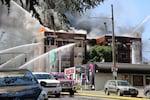
Firefighters battling the fire at the May Apartments in downtown Portland.
Kristian Foden-Vencil / OPB
